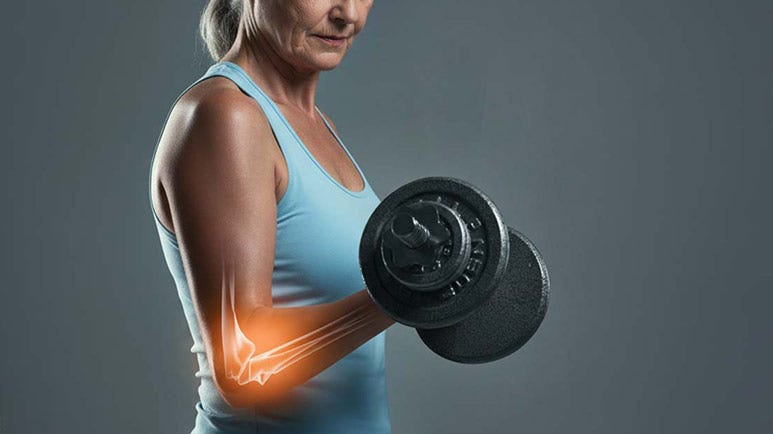How Exercise Protects You from Osteoporosis
Description
STORY AT-A-GLANCE
Osteoporosis affects 10 million Americans, and research shows resistance training effectively builds bone density by creating mechanical stress that signals bone-building cells to strengthen skeletal structure
Weightlifting (80% to 85% of your 1 rep max) performed two to three times weekly produces the greatest bone density gains, while walking and swimming provide insufficient force for bone strengthening
Essential exercises include squats, deadlifts, incline pushups, hip rotations, and chair squats, progressing gradually in intensity while maintaining proper form to minimize injury risk
Blood flow restriction (BFR) training, also known as KAATSU in Japan, enhances bone formation markers even at low intensities, allowing effective muscle and bone strengthening without heavy weights or pain
Consistency matters most. Research shows that training for one year or more significantly improves bone mineral density, cortical thickness, and overall bone geometry across all ages and genders

According to Harvard Health Publishing, around 10 million Americans are now diagnosed with osteoporosis. From that population, around 80% are women. It’s considered to be a silent disease because most people don’t know they have it until they suffer from a simple fall that spontaneously fractures their bones.1
That said, a report from The Conversation noted that one of the best ways to improve bone strength without resorting to drugs is getting regular exercise.2 Simply put, the more you move your body, the more it becomes stronger from a structural point of view.
Resistance Training Sends a Powerful Signal to Your Bones
In a study published in Endocrinology and Metabolism, researchers noted how resistance exercise, commonly known as weightlifting, benefits both bone and muscle health, especially for older adults who are at higher risk for osteoporosis and sarcopenia — two conditions that often occur together and drastically raise the odds of falls and fractures.3
One effective solution that the team highlighted is resistance exercise, which is not only safe, but also highly beneficial for middle aged individuals. Even better, it’s also recommended for frail individuals and those who have already experienced fractures — but safety needs to be kept in mind.
Most forms of weightlifting are good for you — Using free weights, machines, or bands and doing movements like squats, deadlifts, lunges, and back extensions showed consistent results in maintaining or even increasing bone mineral density at key sites like the hip and spine.
Not all exercise types stimulate bone in the same way — Walking, swimming, and cycling provide benefits for your overall fitness, but they do not produce the kind of intensity needed to catalyze your body’s bone-building mechanisms.
<label class="hide-text" contenteditable="false">Text within this block will maintain its original spacing when published</label>In fact, the review points out that “Regular walking, which is frequently prescribed to prevent osteoporosis, also has little or no effect on prevention of bone loss.” That’s because bones become stronger and reform only when they’re loaded with forces greater than what you experience in daily living. In short, upping the intensity by adding weights or through impact-based exercise is the missing ingredient that flips the switch for bone growth.
Best frequency for building strong bones — The authors noted that the most effective programs involved weight training at least two to three times per week, progressively increasing the resistance over time. From their research, high-intensity programs, using around 80% to 85% of a person’s one-repetition maximum (1RM), produced the greatest gains in bone density.
<label class="hide-text" contenteditable="false">Text within this block will maintain its original spacing when published</label>In other words, simply lifting the same weight week after week is not enough. Your bones and muscles need a gradually increasing challenge to adapt. Interestingly, the spine often responded better to resistance exercise than the hip, showing that different parts of the skeleton adapt differently depending on the training.
Intensity is key — Another noteworthy finding is that power training — lifting weights with more speed and explosive movement — maintained bone density in postmenopausal women without increasing risk of injury. This challenges the longstanding idea that older adults need to stick to slow, cautious lifting.
<label class="hide-text" contenteditable="false">Text within this block will maintain its original spacing when published</label>Under proper supervision, training with speed not only strengthens muscles faster but also improves balance and reaction time, which reduces fall risk. For someone worried about frailty, this means that the benefits are double-sided — resistance training keeps your movements sharp and reduces the chances of falls in the first place.
Safety first — While engaging in power training and other forms of medium- and high-intensity exercise stimulates bone growth, it’s important to practice safety, especially if you’ve been diagnosed with osteoporosis already. According to the researchers:4
“[C]urrent exercise guidelines for osteoporosis recommend only moderate-intensity exercises (70% to 80% one RM, eight to 15 repetitions) for individual muscle groups which are insufficient to generate mechanical strain to stimulate an osteogenic response.”
Why bones become stronger through exercise — Bones have specialized cells called osteocytes that act like strain sensors. When you load your skeleton with resistance, those cells detect the impact and send out signals that activate osteoblasts, which are cells responsible for restrengthening bones.
<label class="hide-text" contenteditable="false">Text within this block will maintain its original spacing when published</label>At the same time, the impact also reduces the activity of a protein called sclerostin, which normally acts as a brake on bone growth. By lowering sclerostin, resistance exercise allows the Wnt/β-catenin pathway to stay active, keeping bone-building cells alive longer and ramping up bone formation.
Consistency is key to maximizing benefits — The researchers noted that previously published studies showed that doing resistance exercise consistently for a year or more resulted in significant improv






